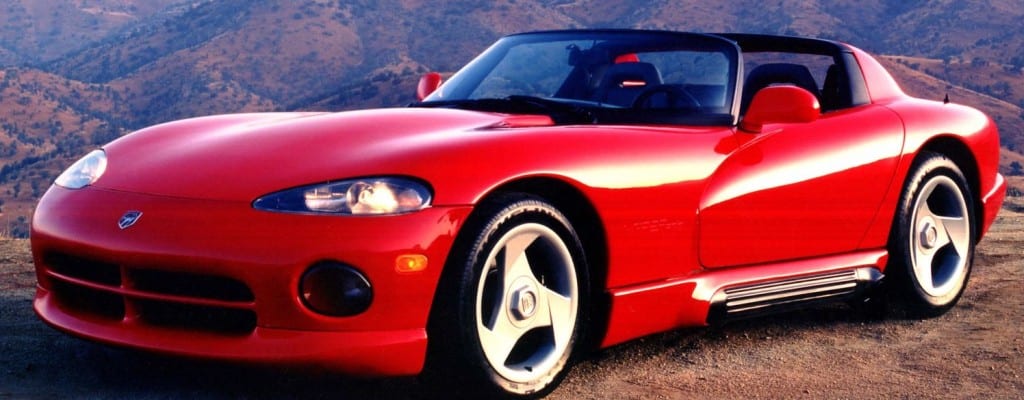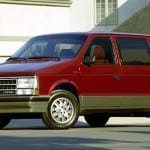The Dodge Viper entered the automotive arena just like any other–as a concept car.
Fawned over by the attendees after its much-anticipated unveiling at Detroit’s 1989 North American International Auto Show, the dream became a production reality three years later.
Unlike some dreams that come true, this fantasy didn’t disappoint, delighting enthusiasts and dealers, like your award-winning Dodge dealership in Miami.
Flying in the face of its compact yet, spacious, ever-practical, and all-American K-car kin, like the 1983 Dodge Aries, the Viper was the K-car’s antithesis. Impractical, sexy, and speedy were its benchmarks. Note: benchmark, not bench seat.
Aptly Named
Chrysler President, Robert A. Lutz, gave the Viper its fearsome name after brainstorming possible monikers on an airplane.
Obviously, the Cobra wasn’t an option. “Sidewinder” was too closely associated with the military and, let’s face it, there would have been no end to the bad jokes and twisted puns. Asp sounds like…well, donkey. And pythons, as Lutz observed, are lazy, fat, pig-swallowers. No good.
Thus, the Viper got its name.
Built to Burn Rubber
Mechanically-minimal, the Viper featured a 6-speed manual transmission, powered by an 8.0-L V10 engine with 4.0-inch cylinder bores and a 3.9-inch stroke. The iron cylinder block would eventually be replaced by a Lamborghini-developed aluminum block. A Lamborghini roaring inside a Dodge.
Although the Eurasian viper snake is not fatal to humans, the forked-tongue force of Lamborghini-Dodge is one lethal combination. Devilish even…
Its full, rounded fenders and fiberglass body were supported by a ladder frame and all-independent suspension. The 3-spoke wheels on steamroller tires spun on the pavement at 300 horsepower with 450 lb.-ft. of torque.
Viper Trumps Cobra
Speaking of horses, Carroll Shelby, the automotive designer, race car driver, and entrepreneur, celebrated for his 1965 Shelby Mustangs, endorsed the Viper as a legitimate and fearsome successor to his 427 Cobra made legendary in the 1960s.
In fact, although Shelby was a performance consultant for Dodge, he did not directly participate in the Viper’s design or creation because he was waiting for a heart transplant. However, the Viper creators still consider him the car’s “conscience.”
The Charmed First Generation
The first generation Viper RT/10 Roadster ran from 1992-1995. The difference between this release and the concept is practically imperceptible. If anyone could tell the difference, no one cared.
Exact features included: a side-mounted exhaust, a seemingly endless one-piece nose, sizable scalloped scoops stretching from the front fenders to the doors, three-spoke 17-inch diameter wheels wrapped in enormous Michelin XGT-Z tires (P275/40ZR17 fronts and ginormous P335/35ZR17 rears), topless two-seater without outside door handles or side windows.
Subtle variations included a bigger windshield, “rollover protection” offered by a hoop behind the cockpit, enlarged headlights and rear view mirrors that might actually dare a peek into the past. Why bother glancing behind when you’re racing ahead?
Scratching the Surface
Okay, beauty is skin deep. We know this. But, the the RT/10 Roadster represented beauty on the inside and out, a near match to the concept Viper in mechanical specifications.
Equipped with the same 8.0-L overhead-valve V10 under the hood, backed by a Tremec T-56 six-speed manual transmission, hissing above an all-independent suspension perched on a tubular steel chassis, big brakes were poised for precise speed interruptions, if necessary. By big, we’re talking really big – 13 inches in diameter for the front and 12-inches in the back. Oh the jokes!
Rack-and-pinion steering maneuvered the now 400 horsepower at 4,600 rpm, with 450 lb-ft of peak torque at 3,600 rpm, speedster. Reminder: this car was released in 1992. Quite a feat!
Blow Me Away!
Not surprisingly, Car and Driver had the privilege of the premier test drive and reported its capability of reaching 60 mph in 4.6 seconds. The quarter-mile practically vanished at 107 mph in 13.2 seconds.
You can still hear the Corvette ZR-1 whining as Car and Driver dubbed the Roadster, “one of the most exciting rides since Ben Hur discovered the chariot.”
Ben Hur? Huh. Wasn’t that the guy who said, “The architect had not stopped to bother about columns and porticos, proportions or interiors, or any limitation upon the epic he sought to materialize; he had simply made a servant of Nature – art can go no further.”
Maybe…but he definitely said, “Pride is never so loud as when in chains.” The Viper ensnared its competition by delivering what it actually promised. Zp it, ZR-1! You’ve been knocked off your iconic pedestal.
Acceleration Ace
Acceleration improved in an additional Car and Driver test, which recorded the Viper’s speed from 0-60 mph at 4.4 seconds, with the quarter-mile consumed at 108 mph in 13.1 seconds.
Beauty Reborn
Reminiscent of the 1965 FIA GT Champion Shelby American, the revamped Vipers from 1996-2002 made their older siblings look like wallflowers.
Sporting Shelby blue with classic white stripes beneath a class Cobra Daytona-inspired roof, the Viper GTS, equipped with an 8.0-L V10 of 450 horsepower, was suddenly able to reach 60 mph in 4.8 seconds.
Other updated features included roll-up side windows, exterior door handles, a rerouted rear exhaust, OBD-II emissions controls, aluminum links in the suspension system, dual front airbags and a lighter-weight frame.
For Extra Fun!
For consumers ready to race their Vipers on the tracks, rather than roadways, the Viper offered the “American Club Racer” (ACR) package, which included one-piece BBS 18-inch wheels, Koni shocks, special springs, a K&N air filter and specific badging. Output of the ACR Vipers, thanks to those modifications, grew to 460 hp.
Not to be excluded, 1999 saw the entire Viper line, whether track or street-ready, upgraded to 18-inch wheels.
2001 brought standard ABS brakes to the Viper and a few special editions in 2002, but the automotive crowd was itching for this snake to shed its skin in favor of new life.
Better With Age
It’s often said about fine wine, less so about people, but the adage, “better with age,” certainly holds true for the second generation of Vipers, with the 2003 production start date. This Viper was made over, this time with a focus on overall refinement.
This Viper was a mature revision of its madcap inception, still super-speedy, but aiming for sophistication.
Daimler-Chrysler’s Street and Racing Technology Group redesigned the Viper as the Viper SRT-10 convertible, equipped with a larger 8.3 L engine, increasing power to 500 horsepower with 525 lb-ft of torque, yet weighing 80 pounds less than the earlier model.
The Viper Mamba, a limited release of 200, red-stitched, black interior bombshells, launched in 2004.
Coupe Classic
Courtesy of the 2006 model year, the second generation coupe with the signature “double-bubble” roof was finally unleashed on the automotive market.
Though perhaps more diminutive in visual upgrades than its topless predecessor, this Viper still stunned, boasting horsepower now up to 510 with 535 lb-ft of torque.
Rather than release a 2007 model, Dodge caught its breath and made 2006 an extended model year in preparation for 2008.
Besting the Competition
The most impressive upgrades for the 2008-2010 Viper SRT-10 Convertible and SRT-10 Coupe represented the combined efforts of McLaren Automotive and Ricardo Consulting Engineers, boosting the engines power 600 horsepower with 560 lb.-ft.
Upgraded to 8.4 liters (510 ci/8354 cc) from 8.3, the engine displacement allowed better flowing heads with larger valves, variable valve timing on the exhaust cam, and dual throttle bodies.
The Current Generation
Dodge skipped a model year in 2011, but came back with full force (literally) in 2012. Armed with a more powerful engine and electronic technology, this current generation of stunning Vipers are lighter and speedier, accelerating even faster to 640 horsepower with 600 lb-ft. of torque.
This snake’s storied evolution should feature in your automotive future.


